KIDS AND LAWS: Overview of Legislations and Regulations
VerifiedAdded on 2022/05/13
|17
|3613
|21
Report
AI Summary
This report provides a comprehensive overview of legislations and regulations concerning children. It begins with an overview of various acts including the Health and Safety at Work Act 1974, Health and Safety (First Aid) Regulation 1981, Manual Handling Operations Regulations 1992, RIDDOR 1995, COSHH 2002, Regulatory Reform (Fire Safety) Order 2005, Food Hygiene (England) Regulations 2006, and the Childcare Act (England) 2006. The report then details how these regulations inform day-to-day practices in childcare, referencing key legislation such as the Equalities Act 2010, Medicines Act 1996, and Children Act 2004, and the Children's Commissioner for Wales Act 2001. Finally, the report outlines the procedures for registering children, emphasizing the importance of first aid, accident reporting, and maintaining safe premises and hygiene standards. The report is a valuable resource for understanding the legal framework governing childcare and ensuring the well-being of children.
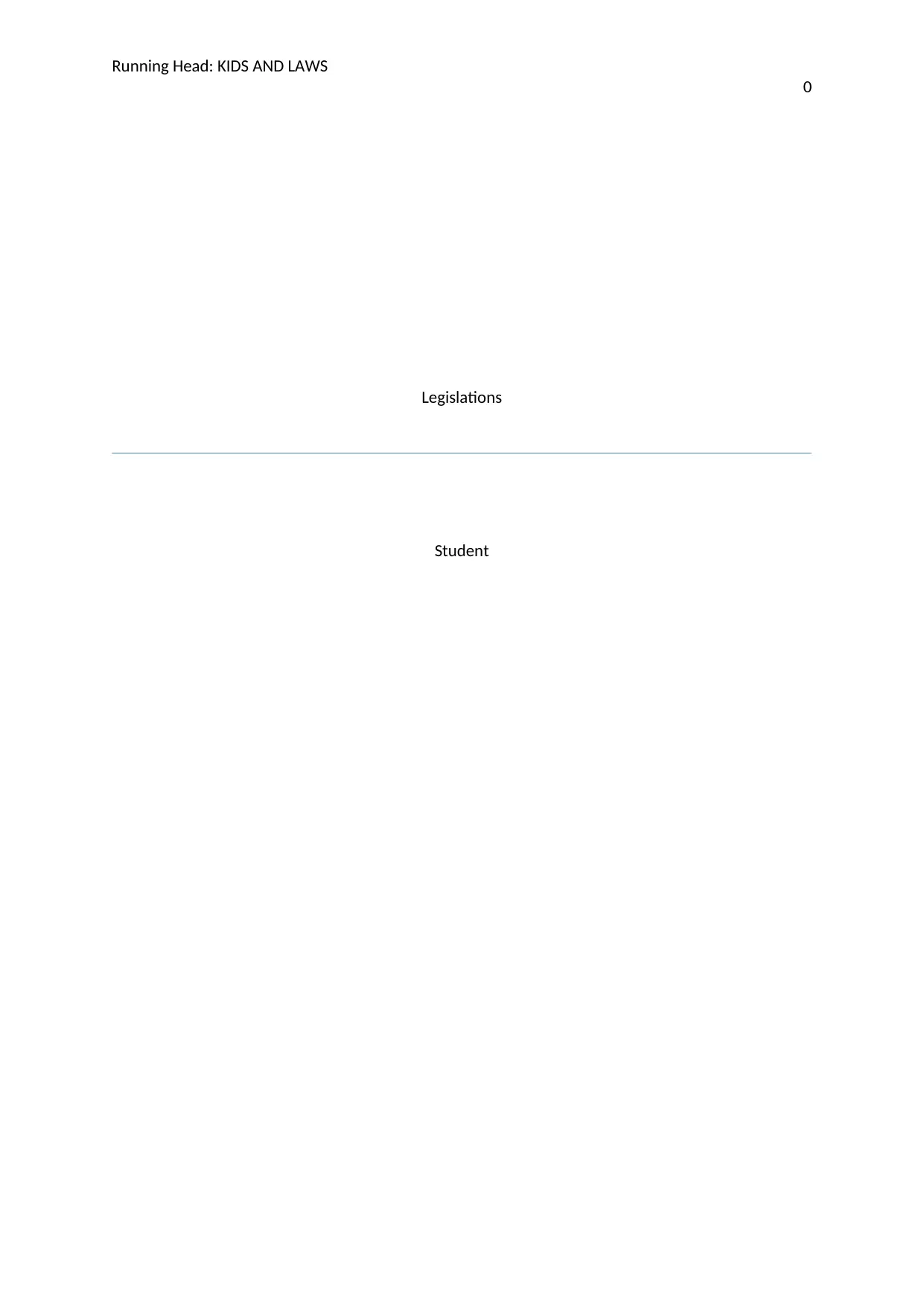
Running Head: KIDS AND LAWS
0
Legislations
Student
0
Legislations
Student
Paraphrase This Document
Need a fresh take? Get an instant paraphrase of this document with our AI Paraphraser
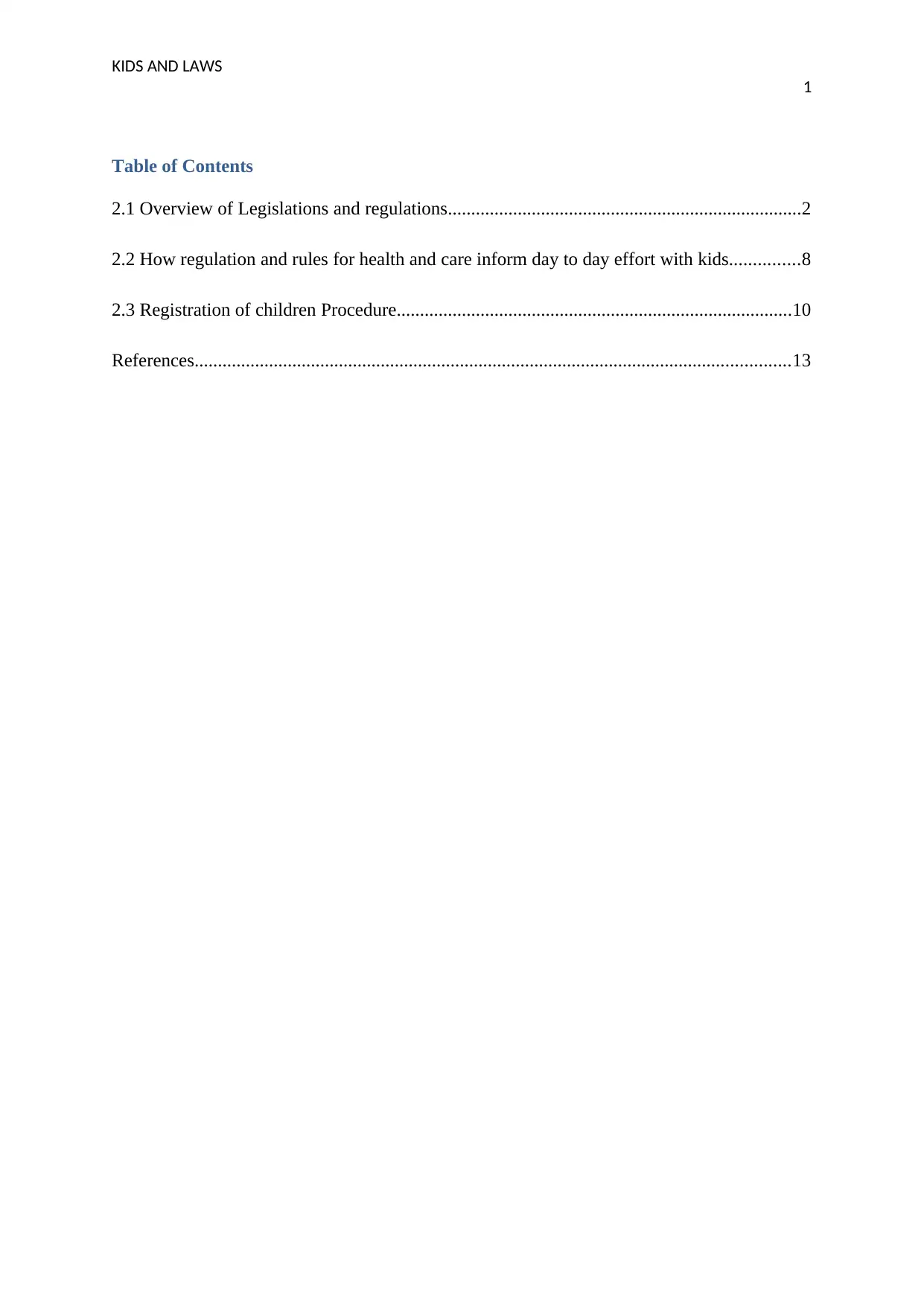
KIDS AND LAWS
1
Table of Contents
2.1 Overview of Legislations and regulations............................................................................2
2.2 How regulation and rules for health and care inform day to day effort with kids...............8
2.3 Registration of children Procedure.....................................................................................10
References................................................................................................................................13
1
Table of Contents
2.1 Overview of Legislations and regulations............................................................................2
2.2 How regulation and rules for health and care inform day to day effort with kids...............8
2.3 Registration of children Procedure.....................................................................................10
References................................................................................................................................13
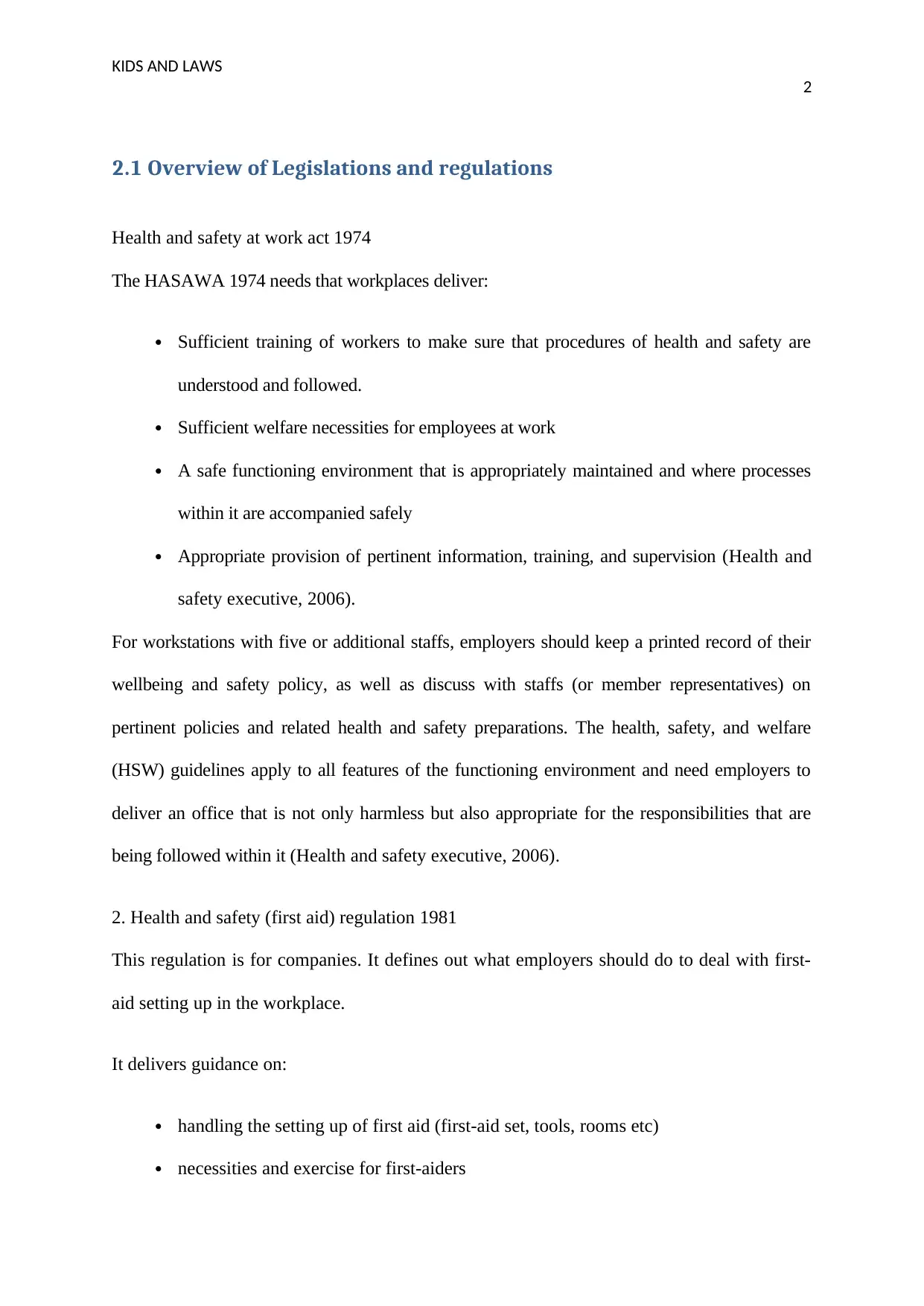
KIDS AND LAWS
2
2.1 Overview of Legislations and regulations
Health and safety at work act 1974
The HASAWA 1974 needs that workplaces deliver:
Sufficient training of workers to make sure that procedures of health and safety are
understood and followed.
Sufficient welfare necessities for employees at work
A safe functioning environment that is appropriately maintained and where processes
within it are accompanied safely
Appropriate provision of pertinent information, training, and supervision (Health and
safety executive, 2006).
For workstations with five or additional staffs, employers should keep a printed record of their
wellbeing and safety policy, as well as discuss with staffs (or member representatives) on
pertinent policies and related health and safety preparations. The health, safety, and welfare
(HSW) guidelines apply to all features of the functioning environment and need employers to
deliver an office that is not only harmless but also appropriate for the responsibilities that are
being followed within it (Health and safety executive, 2006).
2. Health and safety (first aid) regulation 1981
This regulation is for companies. It defines out what employers should do to deal with first-
aid setting up in the workplace.
It delivers guidance on:
handling the setting up of first aid (first-aid set, tools, rooms etc)
necessities and exercise for first-aiders
2
2.1 Overview of Legislations and regulations
Health and safety at work act 1974
The HASAWA 1974 needs that workplaces deliver:
Sufficient training of workers to make sure that procedures of health and safety are
understood and followed.
Sufficient welfare necessities for employees at work
A safe functioning environment that is appropriately maintained and where processes
within it are accompanied safely
Appropriate provision of pertinent information, training, and supervision (Health and
safety executive, 2006).
For workstations with five or additional staffs, employers should keep a printed record of their
wellbeing and safety policy, as well as discuss with staffs (or member representatives) on
pertinent policies and related health and safety preparations. The health, safety, and welfare
(HSW) guidelines apply to all features of the functioning environment and need employers to
deliver an office that is not only harmless but also appropriate for the responsibilities that are
being followed within it (Health and safety executive, 2006).
2. Health and safety (first aid) regulation 1981
This regulation is for companies. It defines out what employers should do to deal with first-
aid setting up in the workplace.
It delivers guidance on:
handling the setting up of first aid (first-aid set, tools, rooms etc)
necessities and exercise for first-aiders
⊘ This is a preview!⊘
Do you want full access?
Subscribe today to unlock all pages.

Trusted by 1+ million students worldwide
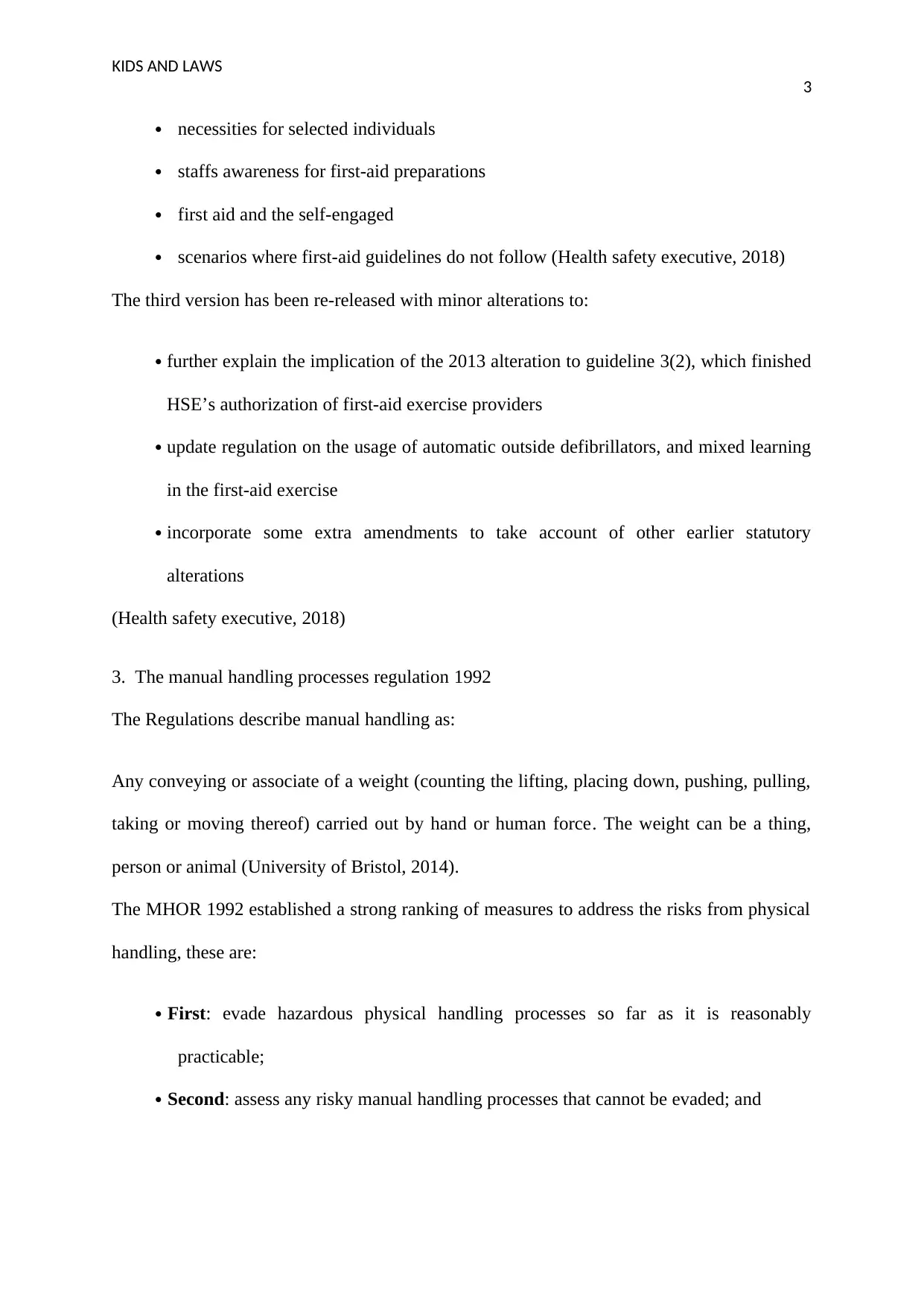
KIDS AND LAWS
3
necessities for selected individuals
staffs awareness for first-aid preparations
first aid and the self-engaged
scenarios where first-aid guidelines do not follow (Health safety executive, 2018)
The third version has been re-released with minor alterations to:
further explain the implication of the 2013 alteration to guideline 3(2), which finished
HSE’s authorization of first-aid exercise providers
update regulation on the usage of automatic outside defibrillators, and mixed learning
in the first-aid exercise
incorporate some extra amendments to take account of other earlier statutory
alterations
(Health safety executive, 2018)
3. The manual handling processes regulation 1992
The Regulations describe manual handling as:
Any conveying or associate of a weight (counting the lifting, placing down, pushing, pulling,
taking or moving thereof) carried out by hand or human force. The weight can be a thing,
person or animal (University of Bristol, 2014).
The MHOR 1992 established a strong ranking of measures to address the risks from physical
handling, these are:
First: evade hazardous physical handling processes so far as it is reasonably
practicable;
Second: assess any risky manual handling processes that cannot be evaded; and
3
necessities for selected individuals
staffs awareness for first-aid preparations
first aid and the self-engaged
scenarios where first-aid guidelines do not follow (Health safety executive, 2018)
The third version has been re-released with minor alterations to:
further explain the implication of the 2013 alteration to guideline 3(2), which finished
HSE’s authorization of first-aid exercise providers
update regulation on the usage of automatic outside defibrillators, and mixed learning
in the first-aid exercise
incorporate some extra amendments to take account of other earlier statutory
alterations
(Health safety executive, 2018)
3. The manual handling processes regulation 1992
The Regulations describe manual handling as:
Any conveying or associate of a weight (counting the lifting, placing down, pushing, pulling,
taking or moving thereof) carried out by hand or human force. The weight can be a thing,
person or animal (University of Bristol, 2014).
The MHOR 1992 established a strong ranking of measures to address the risks from physical
handling, these are:
First: evade hazardous physical handling processes so far as it is reasonably
practicable;
Second: assess any risky manual handling processes that cannot be evaded; and
Paraphrase This Document
Need a fresh take? Get an instant paraphrase of this document with our AI Paraphraser
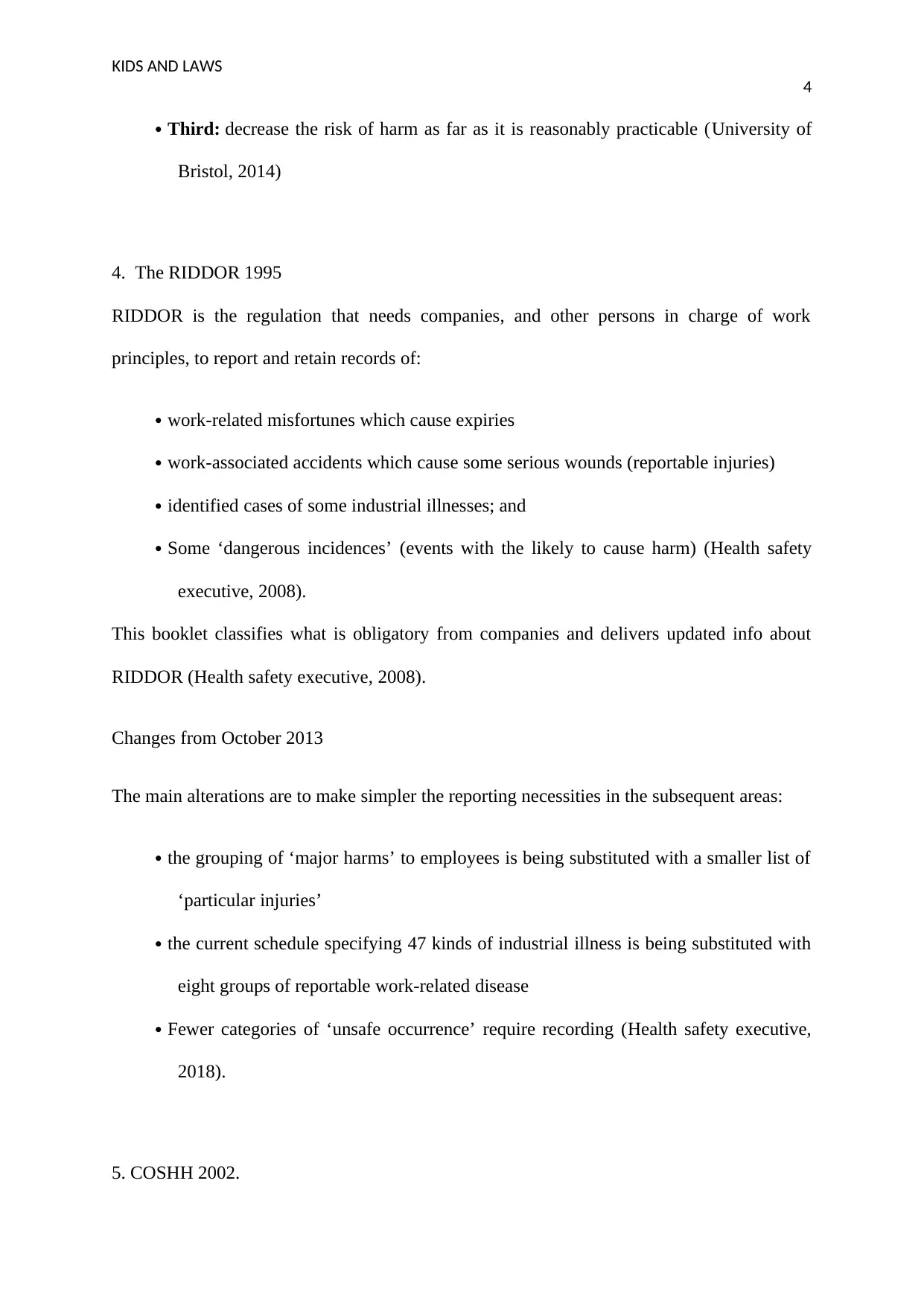
KIDS AND LAWS
4
Third: decrease the risk of harm as far as it is reasonably practicable (University of
Bristol, 2014)
4. The RIDDOR 1995
RIDDOR is the regulation that needs companies, and other persons in charge of work
principles, to report and retain records of:
work-related misfortunes which cause expiries
work-associated accidents which cause some serious wounds (reportable injuries)
identified cases of some industrial illnesses; and
Some ‘dangerous incidences’ (events with the likely to cause harm) (Health safety
executive, 2008).
This booklet classifies what is obligatory from companies and delivers updated info about
RIDDOR (Health safety executive, 2008).
Changes from October 2013
The main alterations are to make simpler the reporting necessities in the subsequent areas:
the grouping of ‘major harms’ to employees is being substituted with a smaller list of
‘particular injuries’
the current schedule specifying 47 kinds of industrial illness is being substituted with
eight groups of reportable work-related disease
Fewer categories of ‘unsafe occurrence’ require recording (Health safety executive,
2018).
5. COSHH 2002.
4
Third: decrease the risk of harm as far as it is reasonably practicable (University of
Bristol, 2014)
4. The RIDDOR 1995
RIDDOR is the regulation that needs companies, and other persons in charge of work
principles, to report and retain records of:
work-related misfortunes which cause expiries
work-associated accidents which cause some serious wounds (reportable injuries)
identified cases of some industrial illnesses; and
Some ‘dangerous incidences’ (events with the likely to cause harm) (Health safety
executive, 2008).
This booklet classifies what is obligatory from companies and delivers updated info about
RIDDOR (Health safety executive, 2008).
Changes from October 2013
The main alterations are to make simpler the reporting necessities in the subsequent areas:
the grouping of ‘major harms’ to employees is being substituted with a smaller list of
‘particular injuries’
the current schedule specifying 47 kinds of industrial illness is being substituted with
eight groups of reportable work-related disease
Fewer categories of ‘unsafe occurrence’ require recording (Health safety executive,
2018).
5. COSHH 2002.
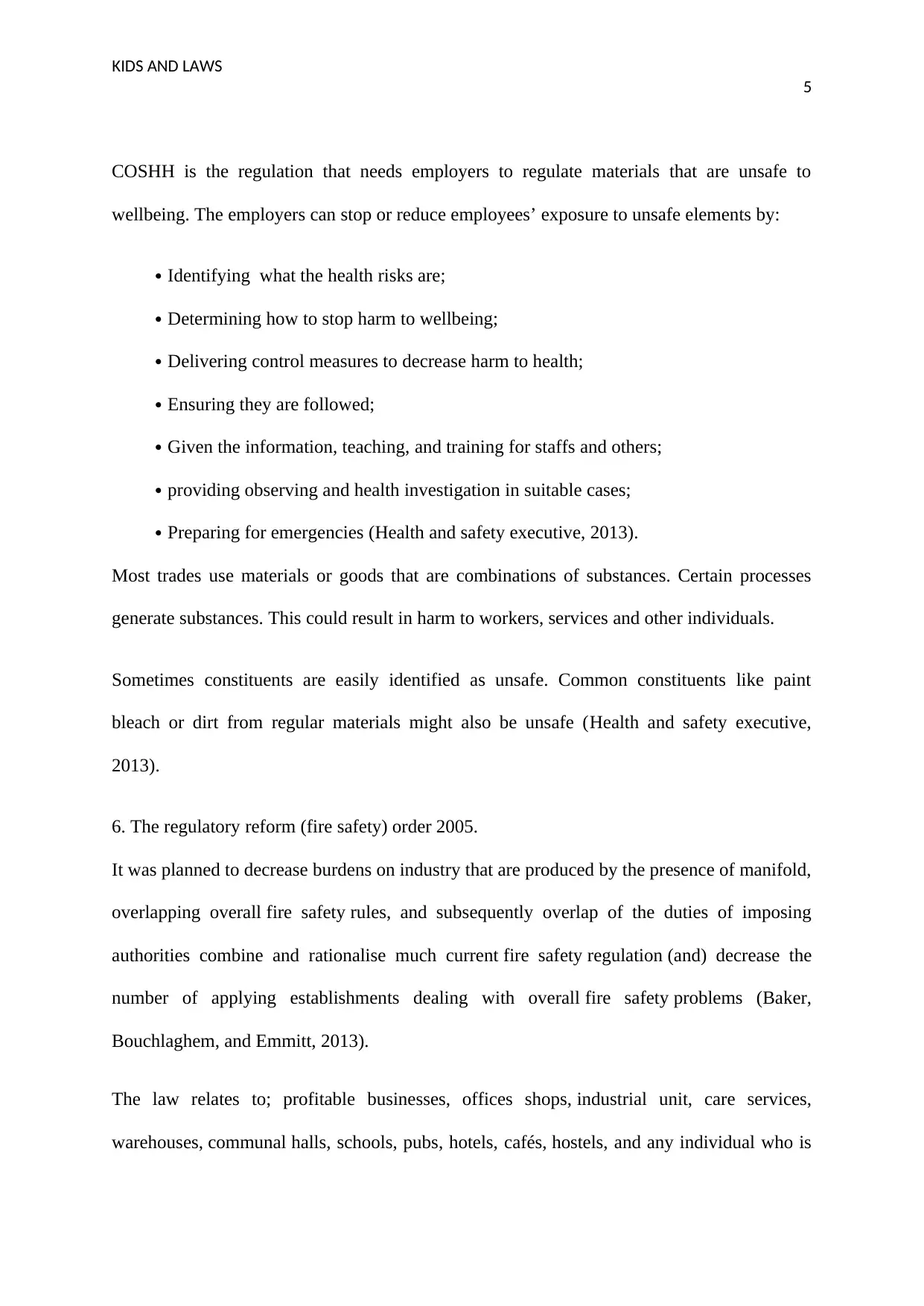
KIDS AND LAWS
5
COSHH is the regulation that needs employers to regulate materials that are unsafe to
wellbeing. The employers can stop or reduce employees’ exposure to unsafe elements by:
Identifying what the health risks are;
Determining how to stop harm to wellbeing;
Delivering control measures to decrease harm to health;
Ensuring they are followed;
Given the information, teaching, and training for staffs and others;
providing observing and health investigation in suitable cases;
Preparing for emergencies (Health and safety executive, 2013).
Most trades use materials or goods that are combinations of substances. Certain processes
generate substances. This could result in harm to workers, services and other individuals.
Sometimes constituents are easily identified as unsafe. Common constituents like paint
bleach or dirt from regular materials might also be unsafe (Health and safety executive,
2013).
6. The regulatory reform (fire safety) order 2005.
It was planned to decrease burdens on industry that are produced by the presence of manifold,
overlapping overall fire safety rules, and subsequently overlap of the duties of imposing
authorities combine and rationalise much current fire safety regulation (and) decrease the
number of applying establishments dealing with overall fire safety problems (Baker,
Bouchlaghem, and Emmitt, 2013).
The law relates to; profitable businesses, offices shops, industrial unit, care services,
warehouses, communal halls, schools, pubs, hotels, cafés, hostels, and any individual who is
5
COSHH is the regulation that needs employers to regulate materials that are unsafe to
wellbeing. The employers can stop or reduce employees’ exposure to unsafe elements by:
Identifying what the health risks are;
Determining how to stop harm to wellbeing;
Delivering control measures to decrease harm to health;
Ensuring they are followed;
Given the information, teaching, and training for staffs and others;
providing observing and health investigation in suitable cases;
Preparing for emergencies (Health and safety executive, 2013).
Most trades use materials or goods that are combinations of substances. Certain processes
generate substances. This could result in harm to workers, services and other individuals.
Sometimes constituents are easily identified as unsafe. Common constituents like paint
bleach or dirt from regular materials might also be unsafe (Health and safety executive,
2013).
6. The regulatory reform (fire safety) order 2005.
It was planned to decrease burdens on industry that are produced by the presence of manifold,
overlapping overall fire safety rules, and subsequently overlap of the duties of imposing
authorities combine and rationalise much current fire safety regulation (and) decrease the
number of applying establishments dealing with overall fire safety problems (Baker,
Bouchlaghem, and Emmitt, 2013).
The law relates to; profitable businesses, offices shops, industrial unit, care services,
warehouses, communal halls, schools, pubs, hotels, cafés, hostels, and any individual who is
⊘ This is a preview!⊘
Do you want full access?
Subscribe today to unlock all pages.

Trusted by 1+ million students worldwide
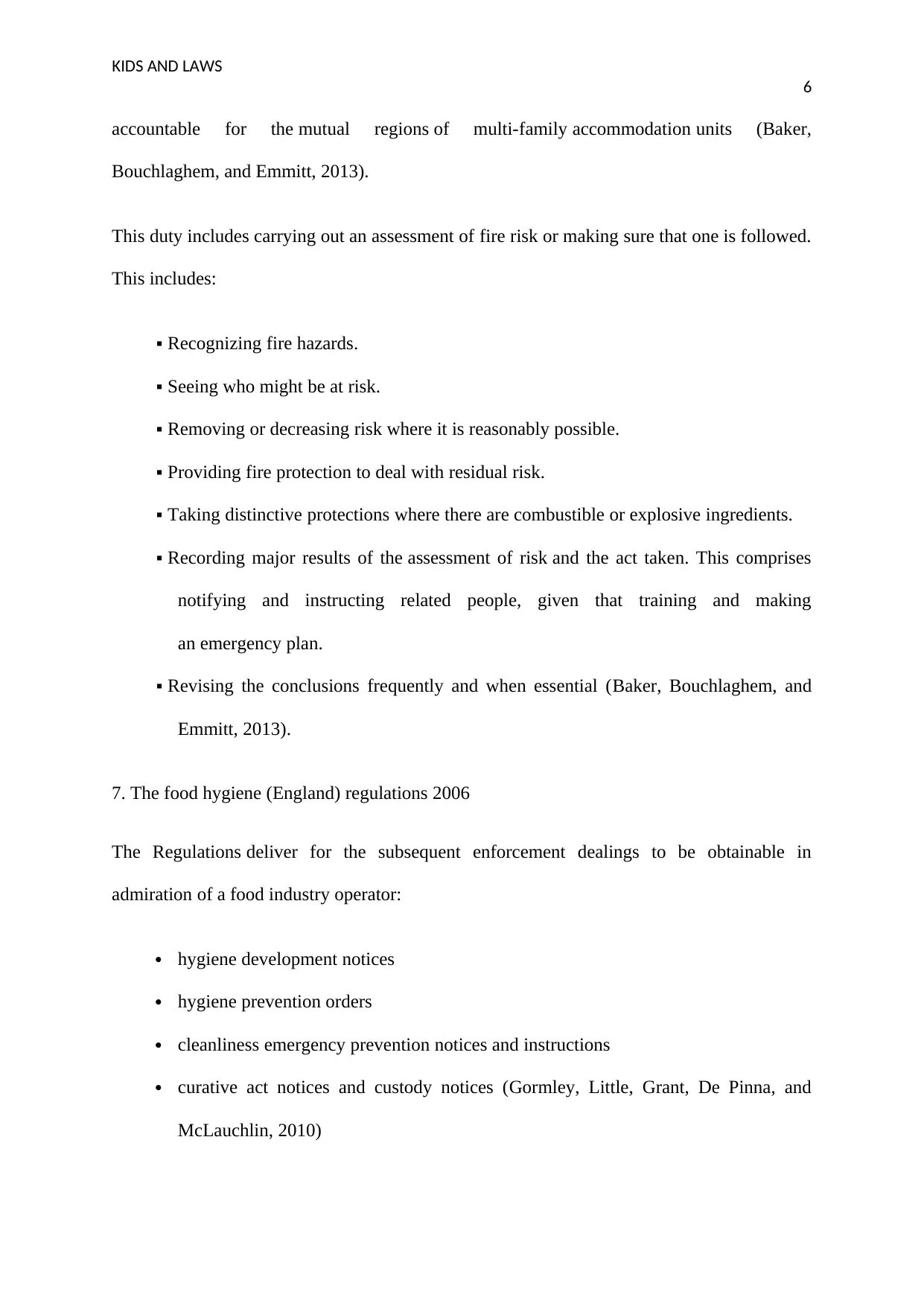
KIDS AND LAWS
6
accountable for the mutual regions of multi-family accommodation units (Baker,
Bouchlaghem, and Emmitt, 2013).
This duty includes carrying out an assessment of fire risk or making sure that one is followed.
This includes:
Recognizing fire hazards.
Seeing who might be at risk.
Removing or decreasing risk where it is reasonably possible.
Providing fire protection to deal with residual risk.
Taking distinctive protections where there are combustible or explosive ingredients.
Recording major results of the assessment of risk and the act taken. This comprises
notifying and instructing related people, given that training and making
an emergency plan.
Revising the conclusions frequently and when essential (Baker, Bouchlaghem, and
Emmitt, 2013).
7. The food hygiene (England) regulations 2006
The Regulations deliver for the subsequent enforcement dealings to be obtainable in
admiration of a food industry operator:
hygiene development notices
hygiene prevention orders
cleanliness emergency prevention notices and instructions
curative act notices and custody notices (Gormley, Little, Grant, De Pinna, and
McLauchlin, 2010)
6
accountable for the mutual regions of multi-family accommodation units (Baker,
Bouchlaghem, and Emmitt, 2013).
This duty includes carrying out an assessment of fire risk or making sure that one is followed.
This includes:
Recognizing fire hazards.
Seeing who might be at risk.
Removing or decreasing risk where it is reasonably possible.
Providing fire protection to deal with residual risk.
Taking distinctive protections where there are combustible or explosive ingredients.
Recording major results of the assessment of risk and the act taken. This comprises
notifying and instructing related people, given that training and making
an emergency plan.
Revising the conclusions frequently and when essential (Baker, Bouchlaghem, and
Emmitt, 2013).
7. The food hygiene (England) regulations 2006
The Regulations deliver for the subsequent enforcement dealings to be obtainable in
admiration of a food industry operator:
hygiene development notices
hygiene prevention orders
cleanliness emergency prevention notices and instructions
curative act notices and custody notices (Gormley, Little, Grant, De Pinna, and
McLauchlin, 2010)
Paraphrase This Document
Need a fresh take? Get an instant paraphrase of this document with our AI Paraphraser
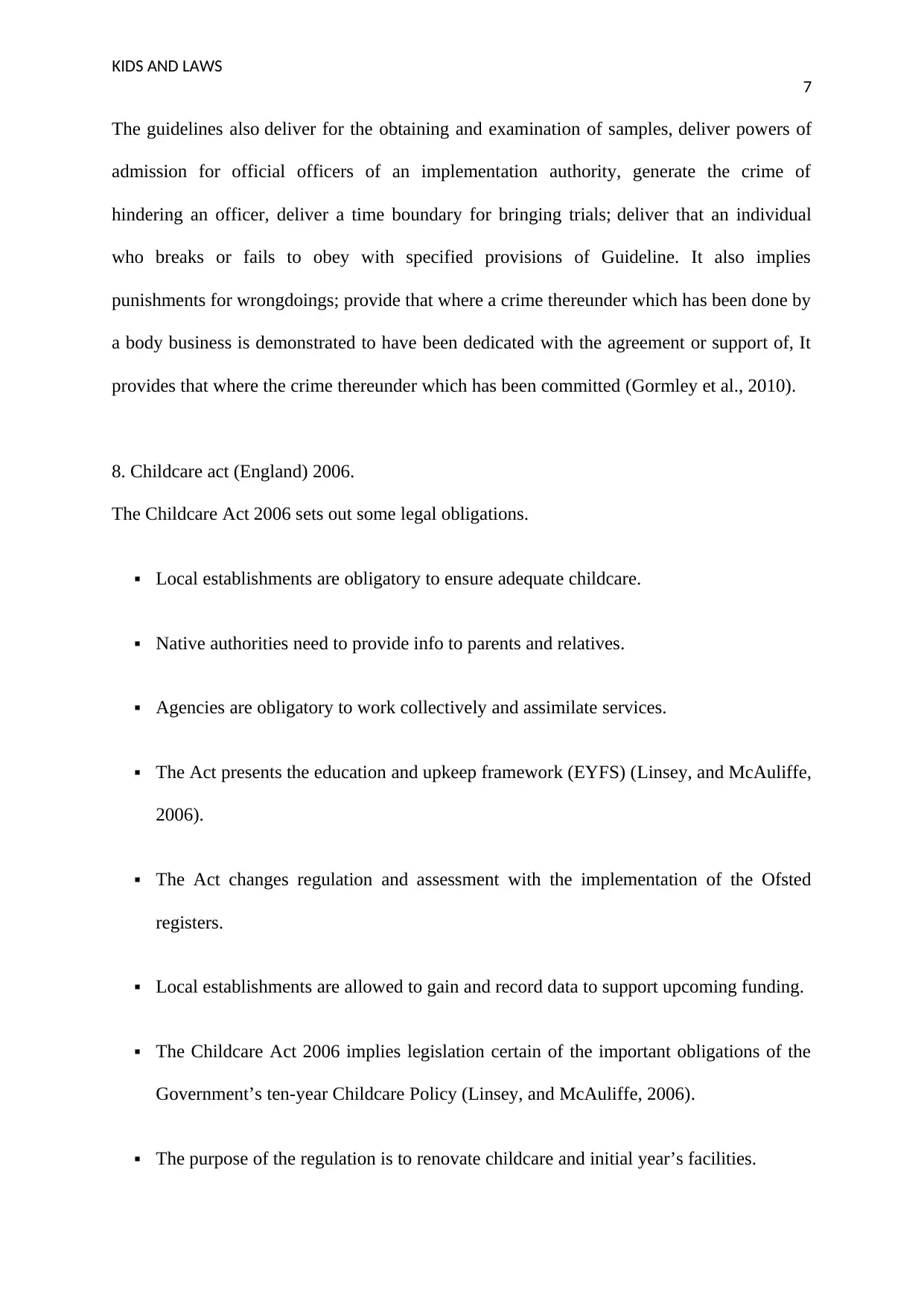
KIDS AND LAWS
7
The guidelines also deliver for the obtaining and examination of samples, deliver powers of
admission for official officers of an implementation authority, generate the crime of
hindering an officer, deliver a time boundary for bringing trials; deliver that an individual
who breaks or fails to obey with specified provisions of Guideline. It also implies
punishments for wrongdoings; provide that where a crime thereunder which has been done by
a body business is demonstrated to have been dedicated with the agreement or support of, It
provides that where the crime thereunder which has been committed (Gormley et al., 2010).
8. Childcare act (England) 2006.
The Childcare Act 2006 sets out some legal obligations.
Local establishments are obligatory to ensure adequate childcare.
Native authorities need to provide info to parents and relatives.
Agencies are obligatory to work collectively and assimilate services.
The Act presents the education and upkeep framework (EYFS) (Linsey, and McAuliffe,
2006).
The Act changes regulation and assessment with the implementation of the Ofsted
registers.
Local establishments are allowed to gain and record data to support upcoming funding.
The Childcare Act 2006 implies legislation certain of the important obligations of the
Government’s ten-year Childcare Policy (Linsey, and McAuliffe, 2006).
The purpose of the regulation is to renovate childcare and initial year’s facilities.
7
The guidelines also deliver for the obtaining and examination of samples, deliver powers of
admission for official officers of an implementation authority, generate the crime of
hindering an officer, deliver a time boundary for bringing trials; deliver that an individual
who breaks or fails to obey with specified provisions of Guideline. It also implies
punishments for wrongdoings; provide that where a crime thereunder which has been done by
a body business is demonstrated to have been dedicated with the agreement or support of, It
provides that where the crime thereunder which has been committed (Gormley et al., 2010).
8. Childcare act (England) 2006.
The Childcare Act 2006 sets out some legal obligations.
Local establishments are obligatory to ensure adequate childcare.
Native authorities need to provide info to parents and relatives.
Agencies are obligatory to work collectively and assimilate services.
The Act presents the education and upkeep framework (EYFS) (Linsey, and McAuliffe,
2006).
The Act changes regulation and assessment with the implementation of the Ofsted
registers.
Local establishments are allowed to gain and record data to support upcoming funding.
The Childcare Act 2006 implies legislation certain of the important obligations of the
Government’s ten-year Childcare Policy (Linsey, and McAuliffe, 2006).
The purpose of the regulation is to renovate childcare and initial year’s facilities.
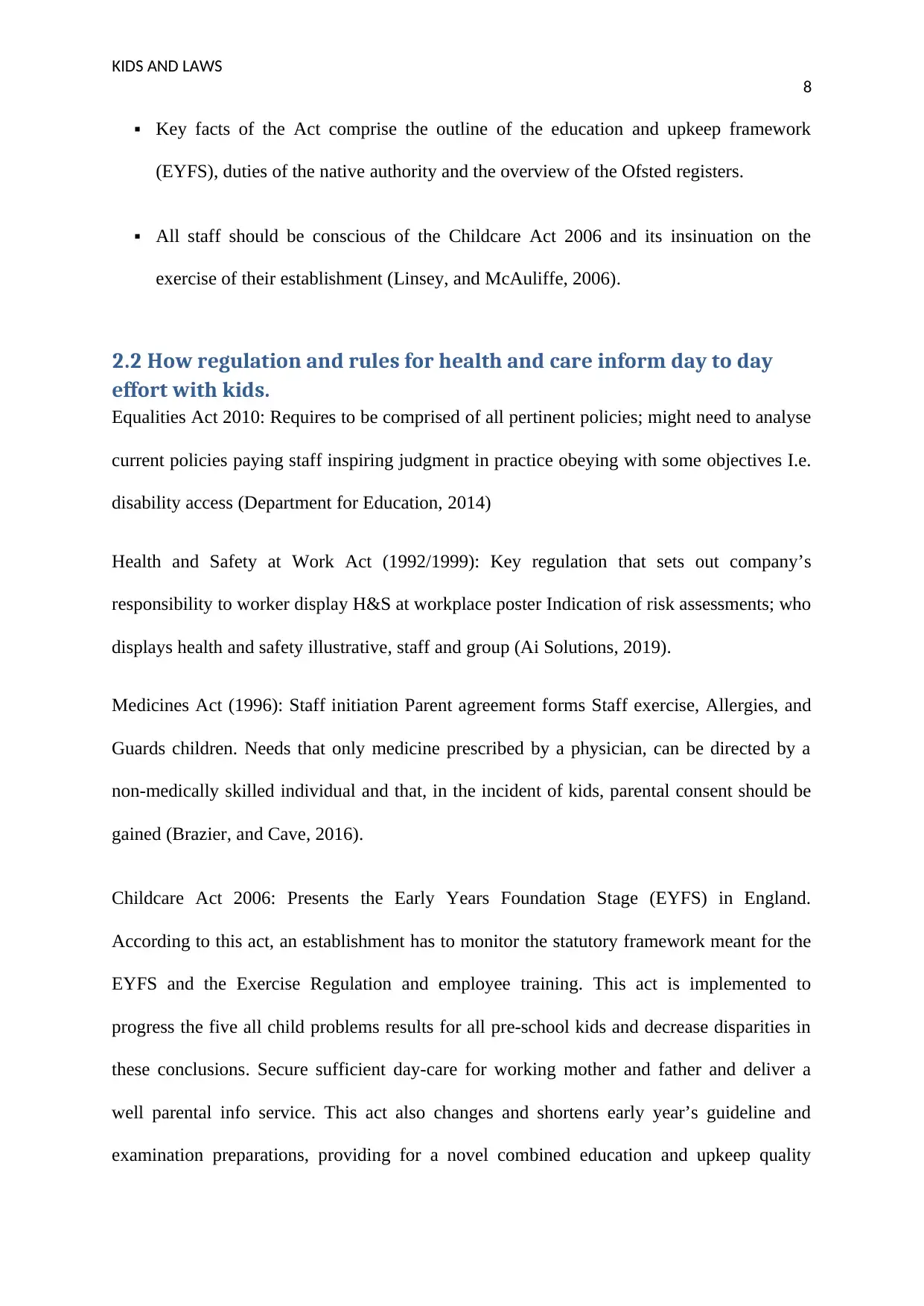
KIDS AND LAWS
8
Key facts of the Act comprise the outline of the education and upkeep framework
(EYFS), duties of the native authority and the overview of the Ofsted registers.
All staff should be conscious of the Childcare Act 2006 and its insinuation on the
exercise of their establishment (Linsey, and McAuliffe, 2006).
2.2 How regulation and rules for health and care inform day to day
effort with kids.
Equalities Act 2010: Requires to be comprised of all pertinent policies; might need to analyse
current policies paying staff inspiring judgment in practice obeying with some objectives I.e.
disability access (Department for Education, 2014)
Health and Safety at Work Act (1992/1999): Key regulation that sets out company’s
responsibility to worker display H&S at workplace poster Indication of risk assessments; who
displays health and safety illustrative, staff and group (Ai Solutions, 2019).
Medicines Act (1996): Staff initiation Parent agreement forms Staff exercise, Allergies, and
Guards children. Needs that only medicine prescribed by a physician, can be directed by a
non-medically skilled individual and that, in the incident of kids, parental consent should be
gained (Brazier, and Cave, 2016).
Childcare Act 2006: Presents the Early Years Foundation Stage (EYFS) in England.
According to this act, an establishment has to monitor the statutory framework meant for the
EYFS and the Exercise Regulation and employee training. This act is implemented to
progress the five all child problems results for all pre-school kids and decrease disparities in
these conclusions. Secure sufficient day-care for working mother and father and deliver a
well parental info service. This act also changes and shortens early year’s guideline and
examination preparations, providing for a novel combined education and upkeep quality
8
Key facts of the Act comprise the outline of the education and upkeep framework
(EYFS), duties of the native authority and the overview of the Ofsted registers.
All staff should be conscious of the Childcare Act 2006 and its insinuation on the
exercise of their establishment (Linsey, and McAuliffe, 2006).
2.2 How regulation and rules for health and care inform day to day
effort with kids.
Equalities Act 2010: Requires to be comprised of all pertinent policies; might need to analyse
current policies paying staff inspiring judgment in practice obeying with some objectives I.e.
disability access (Department for Education, 2014)
Health and Safety at Work Act (1992/1999): Key regulation that sets out company’s
responsibility to worker display H&S at workplace poster Indication of risk assessments; who
displays health and safety illustrative, staff and group (Ai Solutions, 2019).
Medicines Act (1996): Staff initiation Parent agreement forms Staff exercise, Allergies, and
Guards children. Needs that only medicine prescribed by a physician, can be directed by a
non-medically skilled individual and that, in the incident of kids, parental consent should be
gained (Brazier, and Cave, 2016).
Childcare Act 2006: Presents the Early Years Foundation Stage (EYFS) in England.
According to this act, an establishment has to monitor the statutory framework meant for the
EYFS and the Exercise Regulation and employee training. This act is implemented to
progress the five all child problems results for all pre-school kids and decrease disparities in
these conclusions. Secure sufficient day-care for working mother and father and deliver a
well parental info service. This act also changes and shortens early year’s guideline and
examination preparations, providing for a novel combined education and upkeep quality
⊘ This is a preview!⊘
Do you want full access?
Subscribe today to unlock all pages.

Trusted by 1+ million students worldwide
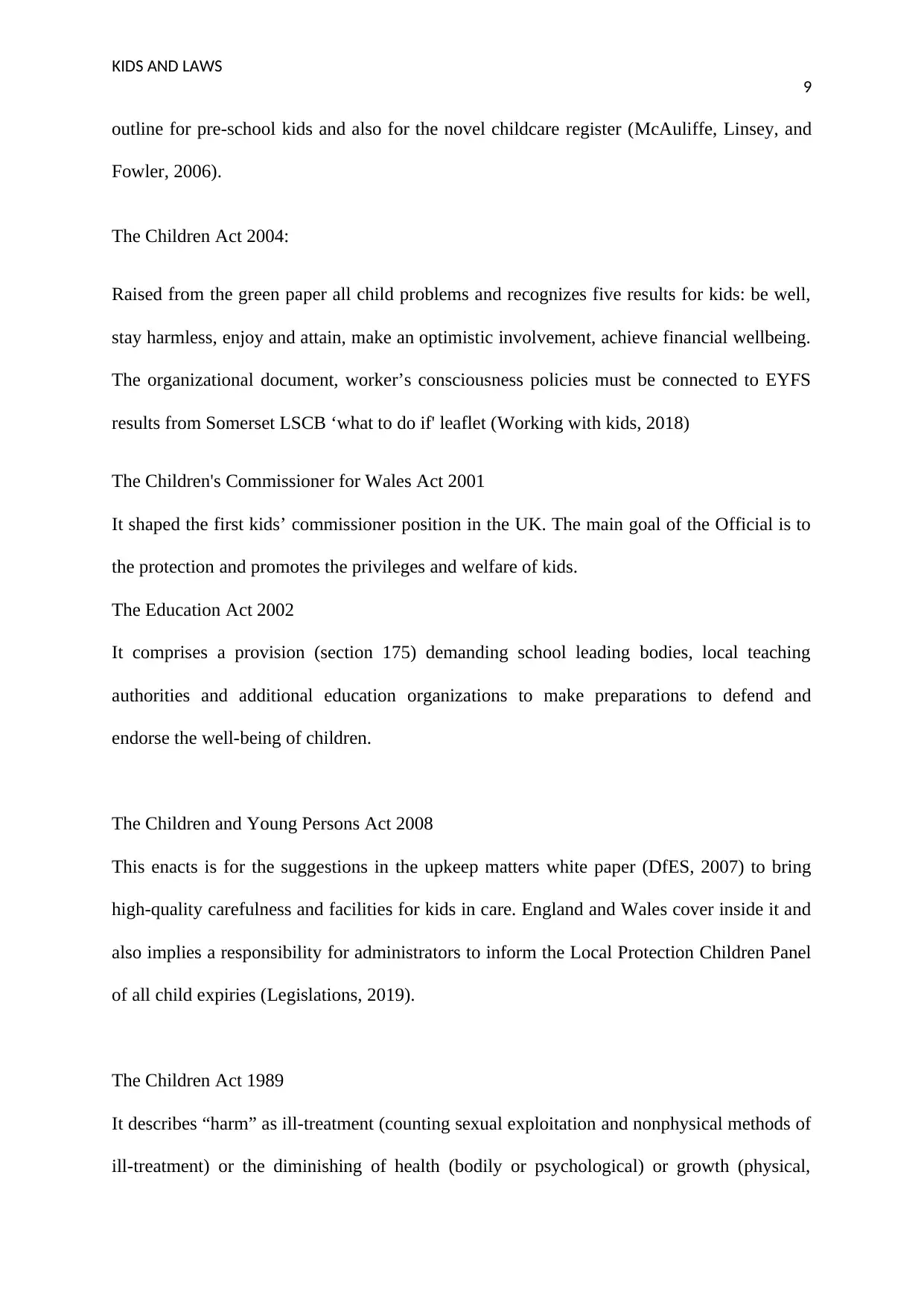
KIDS AND LAWS
9
outline for pre-school kids and also for the novel childcare register (McAuliffe, Linsey, and
Fowler, 2006).
The Children Act 2004:
Raised from the green paper all child problems and recognizes five results for kids: be well,
stay harmless, enjoy and attain, make an optimistic involvement, achieve financial wellbeing.
The organizational document, worker’s consciousness policies must be connected to EYFS
results from Somerset LSCB ‘what to do if' leaflet (Working with kids, 2018)
The Children's Commissioner for Wales Act 2001
It shaped the first kids’ commissioner position in the UK. The main goal of the Official is to
the protection and promotes the privileges and welfare of kids.
The Education Act 2002
It comprises a provision (section 175) demanding school leading bodies, local teaching
authorities and additional education organizations to make preparations to defend and
endorse the well-being of children.
The Children and Young Persons Act 2008
This enacts is for the suggestions in the upkeep matters white paper (DfES, 2007) to bring
high-quality carefulness and facilities for kids in care. England and Wales cover inside it and
also implies a responsibility for administrators to inform the Local Protection Children Panel
of all child expiries (Legislations, 2019).
The Children Act 1989
It describes “harm” as ill-treatment (counting sexual exploitation and nonphysical methods of
ill-treatment) or the diminishing of health (bodily or psychological) or growth (physical,
9
outline for pre-school kids and also for the novel childcare register (McAuliffe, Linsey, and
Fowler, 2006).
The Children Act 2004:
Raised from the green paper all child problems and recognizes five results for kids: be well,
stay harmless, enjoy and attain, make an optimistic involvement, achieve financial wellbeing.
The organizational document, worker’s consciousness policies must be connected to EYFS
results from Somerset LSCB ‘what to do if' leaflet (Working with kids, 2018)
The Children's Commissioner for Wales Act 2001
It shaped the first kids’ commissioner position in the UK. The main goal of the Official is to
the protection and promotes the privileges and welfare of kids.
The Education Act 2002
It comprises a provision (section 175) demanding school leading bodies, local teaching
authorities and additional education organizations to make preparations to defend and
endorse the well-being of children.
The Children and Young Persons Act 2008
This enacts is for the suggestions in the upkeep matters white paper (DfES, 2007) to bring
high-quality carefulness and facilities for kids in care. England and Wales cover inside it and
also implies a responsibility for administrators to inform the Local Protection Children Panel
of all child expiries (Legislations, 2019).
The Children Act 1989
It describes “harm” as ill-treatment (counting sexual exploitation and nonphysical methods of
ill-treatment) or the diminishing of health (bodily or psychological) or growth (physical,
Paraphrase This Document
Need a fresh take? Get an instant paraphrase of this document with our AI Paraphraser
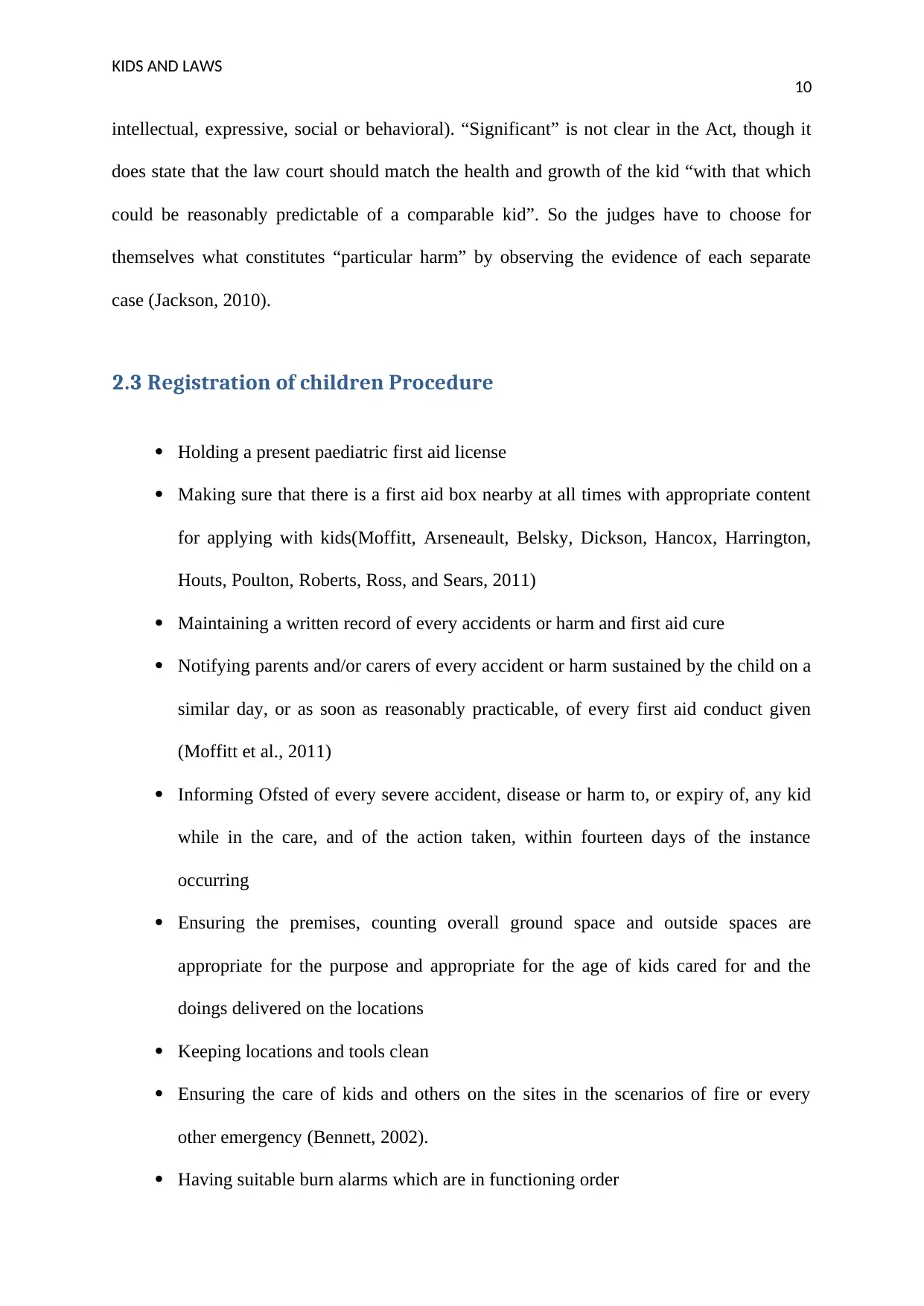
KIDS AND LAWS
10
intellectual, expressive, social or behavioral). “Significant” is not clear in the Act, though it
does state that the law court should match the health and growth of the kid “with that which
could be reasonably predictable of a comparable kid”. So the judges have to choose for
themselves what constitutes “particular harm” by observing the evidence of each separate
case (Jackson, 2010).
2.3 Registration of children Procedure
Holding a present paediatric first aid license
Making sure that there is a first aid box nearby at all times with appropriate content
for applying with kids(Moffitt, Arseneault, Belsky, Dickson, Hancox, Harrington,
Houts, Poulton, Roberts, Ross, and Sears, 2011)
Maintaining a written record of every accidents or harm and first aid cure
Notifying parents and/or carers of every accident or harm sustained by the child on a
similar day, or as soon as reasonably practicable, of every first aid conduct given
(Moffitt et al., 2011)
Informing Ofsted of every severe accident, disease or harm to, or expiry of, any kid
while in the care, and of the action taken, within fourteen days of the instance
occurring
Ensuring the premises, counting overall ground space and outside spaces are
appropriate for the purpose and appropriate for the age of kids cared for and the
doings delivered on the locations
Keeping locations and tools clean
Ensuring the care of kids and others on the sites in the scenarios of fire or every
other emergency (Bennett, 2002).
Having suitable burn alarms which are in functioning order
10
intellectual, expressive, social or behavioral). “Significant” is not clear in the Act, though it
does state that the law court should match the health and growth of the kid “with that which
could be reasonably predictable of a comparable kid”. So the judges have to choose for
themselves what constitutes “particular harm” by observing the evidence of each separate
case (Jackson, 2010).
2.3 Registration of children Procedure
Holding a present paediatric first aid license
Making sure that there is a first aid box nearby at all times with appropriate content
for applying with kids(Moffitt, Arseneault, Belsky, Dickson, Hancox, Harrington,
Houts, Poulton, Roberts, Ross, and Sears, 2011)
Maintaining a written record of every accidents or harm and first aid cure
Notifying parents and/or carers of every accident or harm sustained by the child on a
similar day, or as soon as reasonably practicable, of every first aid conduct given
(Moffitt et al., 2011)
Informing Ofsted of every severe accident, disease or harm to, or expiry of, any kid
while in the care, and of the action taken, within fourteen days of the instance
occurring
Ensuring the premises, counting overall ground space and outside spaces are
appropriate for the purpose and appropriate for the age of kids cared for and the
doings delivered on the locations
Keeping locations and tools clean
Ensuring the care of kids and others on the sites in the scenarios of fire or every
other emergency (Bennett, 2002).
Having suitable burn alarms which are in functioning order
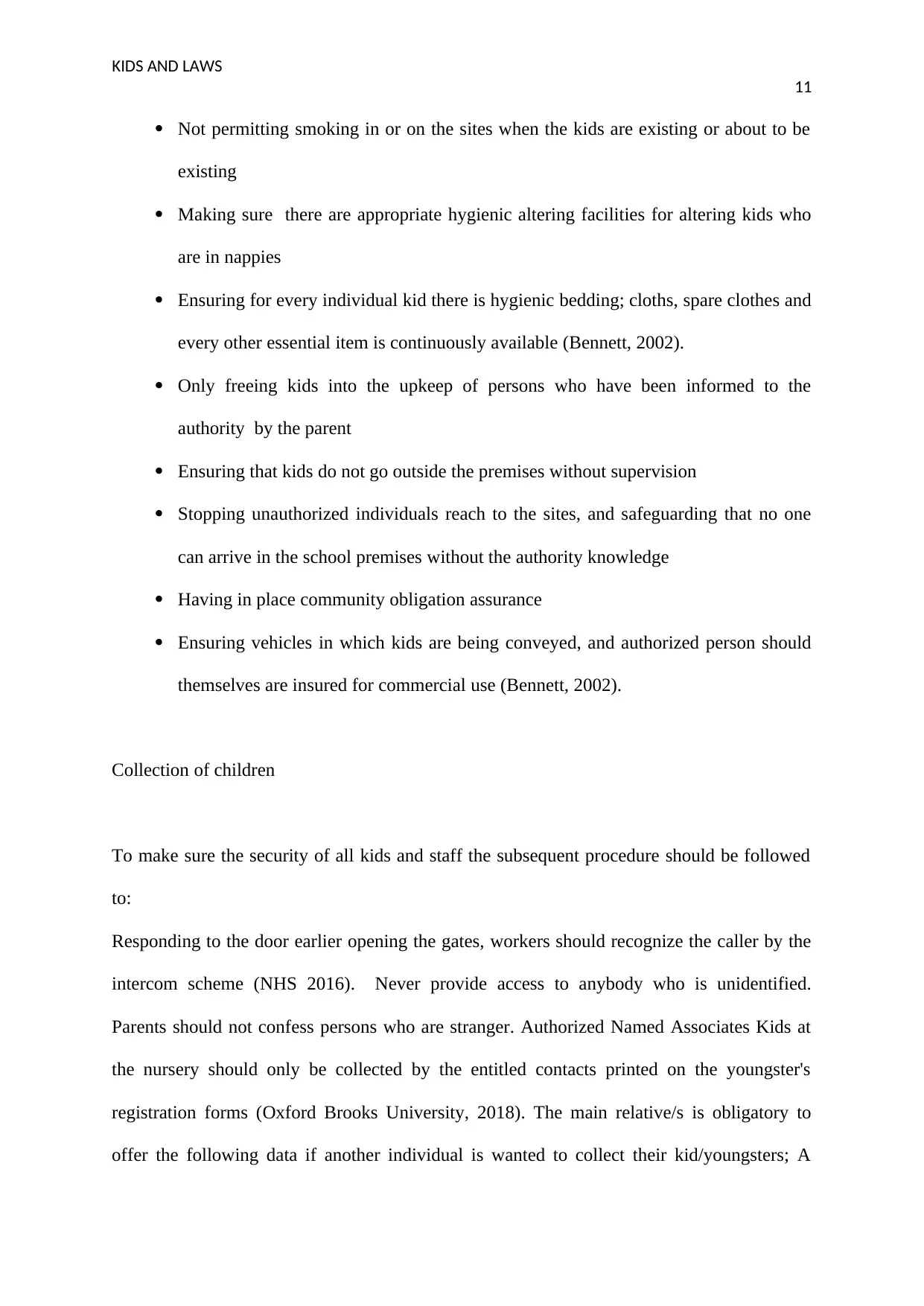
KIDS AND LAWS
11
Not permitting smoking in or on the sites when the kids are existing or about to be
existing
Making sure there are appropriate hygienic altering facilities for altering kids who
are in nappies
Ensuring for every individual kid there is hygienic bedding; cloths, spare clothes and
every other essential item is continuously available (Bennett, 2002).
Only freeing kids into the upkeep of persons who have been informed to the
authority by the parent
Ensuring that kids do not go outside the premises without supervision
Stopping unauthorized individuals reach to the sites, and safeguarding that no one
can arrive in the school premises without the authority knowledge
Having in place community obligation assurance
Ensuring vehicles in which kids are being conveyed, and authorized person should
themselves are insured for commercial use (Bennett, 2002).
Collection of children
To make sure the security of all kids and staff the subsequent procedure should be followed
to:
Responding to the door earlier opening the gates, workers should recognize the caller by the
intercom scheme (NHS 2016). Never provide access to anybody who is unidentified.
Parents should not confess persons who are stranger. Authorized Named Associates Kids at
the nursery should only be collected by the entitled contacts printed on the youngster's
registration forms (Oxford Brooks University, 2018). The main relative/s is obligatory to
offer the following data if another individual is wanted to collect their kid/youngsters; A
11
Not permitting smoking in or on the sites when the kids are existing or about to be
existing
Making sure there are appropriate hygienic altering facilities for altering kids who
are in nappies
Ensuring for every individual kid there is hygienic bedding; cloths, spare clothes and
every other essential item is continuously available (Bennett, 2002).
Only freeing kids into the upkeep of persons who have been informed to the
authority by the parent
Ensuring that kids do not go outside the premises without supervision
Stopping unauthorized individuals reach to the sites, and safeguarding that no one
can arrive in the school premises without the authority knowledge
Having in place community obligation assurance
Ensuring vehicles in which kids are being conveyed, and authorized person should
themselves are insured for commercial use (Bennett, 2002).
Collection of children
To make sure the security of all kids and staff the subsequent procedure should be followed
to:
Responding to the door earlier opening the gates, workers should recognize the caller by the
intercom scheme (NHS 2016). Never provide access to anybody who is unidentified.
Parents should not confess persons who are stranger. Authorized Named Associates Kids at
the nursery should only be collected by the entitled contacts printed on the youngster's
registration forms (Oxford Brooks University, 2018). The main relative/s is obligatory to
offer the following data if another individual is wanted to collect their kid/youngsters; A
⊘ This is a preview!⊘
Do you want full access?
Subscribe today to unlock all pages.

Trusted by 1+ million students worldwide
1 out of 17
Your All-in-One AI-Powered Toolkit for Academic Success.
+13062052269
info@desklib.com
Available 24*7 on WhatsApp / Email
![[object Object]](/_next/static/media/star-bottom.7253800d.svg)
Unlock your academic potential
Copyright © 2020–2025 A2Z Services. All Rights Reserved. Developed and managed by ZUCOL.


